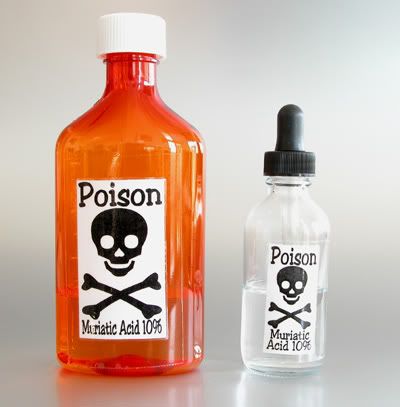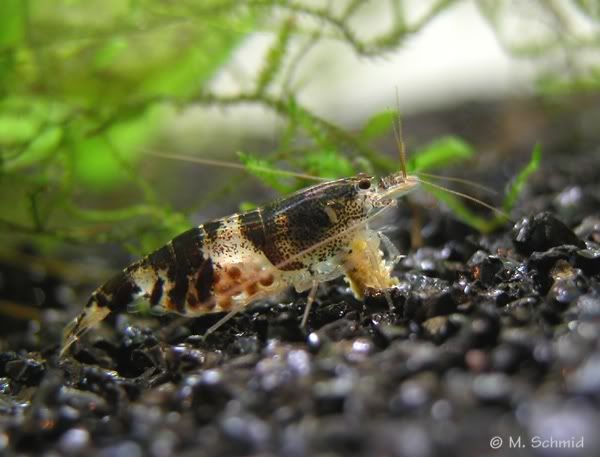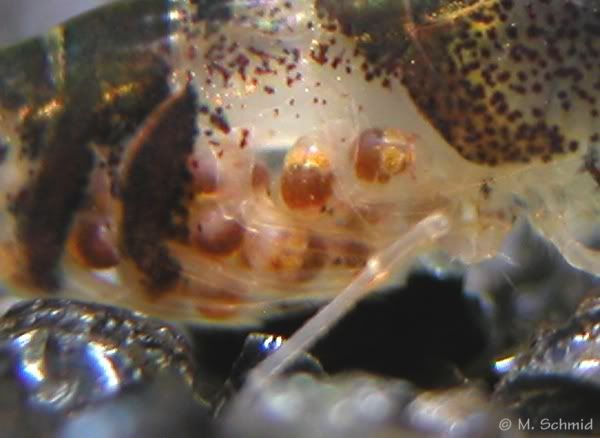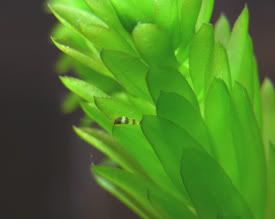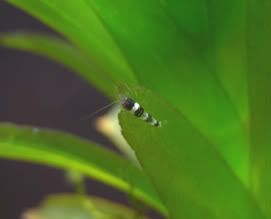Hi everyone, I'm finally able to update my Bumblebee situation. The reason for not doing so earlier is because in previous attempts at raising them, I was still having shrimplet losses all the way up to the 6-weeks-old mark. So I wanted to be fairly certain I was on the right track before posting. However, I'm realizing that the fact that I was able to lower my pH to help out my current crop of shrimplets is worth mentioning now. I don't have a lot of shrimplets, but the ones I can see are doing well

.
To start where I last left off, at the urging of Mustafa, I got myself a reliable pH meter, the Hanna pHep 5 and boy am I glad I did! It reiterated the fact that some of those strip-type test kits were totally useless for me and the drops test kit did not help me much either. Rather, it kept me from knowing what my tank parameter problems were, thereby delaying the working out of those problems.
So on to the problems... they were twofold - for one, I was WAY off the mark as to what my true pH was. Depending on which tank and when tested, my pH meter let me know it ran anywhere from 8.1 - 8.5! Oh, those poor Bumblebees

.
Secondly, like some of you living in particular parts of the country (usually urban?), the water company here puts stuff in the water to keep it basic (Mustafa mentions this earlier in the thread and elsewhere). That is why my attempts at diluting the tap water with distilled water failed - it would only bring the pH down temporarily, only to bounce back to exactly where it was, in the next few days. I was told from another source that if I wanted go that route, in order to avoid the bounce-back problem, I'd have to get drinking water from another source (like those vending machines you can find outside of some grocery stores - those are supposed to be 7.0 pH) and NOT put ANY of my tap water in, or I'd be right back to where I started.
Just a side note concerning tap water in our area. I read some time ago that for most of the year, the water comes from reservoirs; however, at other times it comes locally. By that I take it it comes from local mountain streams that get filtered naturally through sediments in those streams (I guess a water table?). I've noted that tap water here, for most of the year is in the 8.0+ range. But I was shocked to discover that in recent weeks/months (winter), it was coming out at a stunning 6.6!!! HOWEVER, it still bounces back to over the 8.0 range within a day of being in the tank (added as part of the weekly WC). I'm not sure if that's attributed to the fact the water company still puts the basic producing stuff in - or because I still have part of my old tap water in there ... probably both, but regardless, it still boils down to "problem."
Okay, so on to solving the problem. I looked at a variety of ways to tackle it, naturally, they all have a learning curve and have their pluses and minuses. Ironically, due to the fact that I'm totally into keeping "simple" shrimp tanks and being a bit of a purist about it, I decided on the route that scared me the most - the muriatic acid (Hcl) method previously mentioned by Mustafa (Thanks so much for the info, Mustafa! Best choice I made, along with getting a proper pH meter). The funny thing is, what actually made me feel okay about deciding to try it is, I read that Hcl is the same thing that's in your stomach - stomach acid. Yeah, go figure why it made feel better about using it - strange female logic?

Kidding aside, I guess it made me realize that the concept of acidic and basic are a naturally occurring phenomenon, and that Hcl was the most direct, "pure" way to bring pH down in my tanks (like they say in commercials, "no additives, fillers, yadda yadda"). Not only that, but it gives your precise and complete control - instantly.
Let me say first and foremost that if anyone with a huge pH problem goes this route, it will make things 100% easier if you work everything out first in a tank without inhabitants - if your problems are anything like mine, you will have constant "bounces" of your pH until the acid eats away at the basic and finally settles down to a more manageable level - but at least you can add the acid at your own time schedule. But it can be done to already existing tanks with inhabitants, if you can provide the time and willingness to stick with it. I had to do this with my tanks that had 2 pregnant BB females, which meant that I wanted to approach it slowly and systematically and keep stress to a minimum (that's just my way). Mustafa had earlier mentioned that it's not necessarily bad for them to go to the down side on pH quickly - but my big concern was the radical upswing that would follow. Thus, I went about it in steps.
I kept copious notes writing down pH readings every hour. The bad part was that I had to add a drop every hour, that's how insidious the basic water was for me! I created a "target" and kept to it by applying a drop when it went past a certain point. For example, when I first started, I made my target 8.0 and allowed a .1 fluctuation on either side (between 7.9 - 8.1). So every time it went over 8.0, I would add a drop. Then in the following days, I would reduce my "target" (ie., 7.9 target; range of 7.8 - 8.0) and continued to keep at it. It took me about 9 days of doing this to get it to the point where I only had to apply the occasional drop. Depending on your acid solution (mine was a solution of 10% muriatic acid, 90% water) you'll get a feel for how much one drop of the acid solution produces. Mine was about .07 difference per acid drop in a 10 gal tank. But remember that it can fluctuate depending on other factors, so always take pH readings before and after the drops until you get the complete hang of it. Also, pH rises during lights-on hours so during the initial phase, I kept the lights off when I wasn't home and unable to keep up with the acid drops. Now everything is back to normal schedule; I still check pH at least a couple times a day (especially during lights-on hours) and add a drop if it's over my target, but that's about it. Don't overshoot, especially just before lights-out hours, since during off hours, the pH can subside.
Sorry for the long post! I'll leave it here for now. Next time around, if Mustafa doesn't mind, I'll post the very clear instructions for how to procure and use the muriatic acid he provided. I think he mentions somewhere on the forum that he might want to do a write up on it, but those things can take time. In the meanwhile, I'm sure there are others out there who have major problems getting their pH under control. Now that I have complete control over the pH, I feel like I can keep any kind of shrimp or fish I want, as long as I know what their preferred pH requirements are!
Thanks again, Mustafa.

-GB
So, we are in two completely different industries.

... Experience really counts and that's my advantage.





